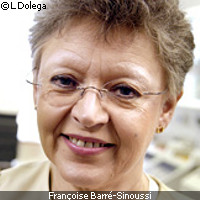Three Europeans scoop Nobel Prize for Medicine
The Nobel Assembly on 6 October awarded the Nobel Prize in Physiology or Medicine for 2008 to Harald zur Hausen for his discovery of human papilloma viruses (HPV) causing cervical cancer and to Françoise Barré-Sinoussi and Luc Montagnier for their discovery of human immunodeficiency virus (HIV). The German and French laureates will share the SEK 10 million (EUR 1.03 million) prize, with half going to Professor zur Hausen and the other half shared between Drs Barré-Sinoussi and Montagnier. The discovery by co-investigators Drs Barré-Sinoussi and Montagnier's of the HIV retrovirus in 1983 made rapid cloning of the HIV-1 genome possible and led to the development of an HIV screening test for patients and blood products, limiting the spread of the HIV/AIDS pandemic. Their knowledge of the HIV viral replication cycle also led to the development of several classes of antiviral drugs. According to The Nobel Foundation, 'The significance of their achievements should be viewed in the context of a global ubiquitous epidemic affecting close to 1% of the population.' Professor zur Hausen detected human papilloma virus (HPV) types and isolated the HPV 16 and 18 strains. His discoveries have led to an understanding of cervical cancer that has paved the way for the development of preventive vaccines. HPV is directly linked to cervical cancer, which is a common cancer in women and accounts for more early-age deaths in developing countries than breast cancer. Dr Barré-Sinoussi, director of the Regulation of Retroviral Infections Union at the Institut Pasteur in France, has been involved in retroviral research since the 1970s and has been tirelessly dedicated to establishing permanent links between basic and clinical HIV/AIDS research. In a 2006 interview with Women in Technology International, she said that since her discovery, AIDS research has become her major personal and professional preoccupation and is the central feature of her life. She explained: 'It is difficult to be satisfied with the situation since, after 25 years of joint efforts, the epidemic continues unabated across the world [...] There has certainly been progress, but globally it pains the heart to see the ravages of this illness. Every year millions of people contract the virus, and others die. It is difficult for a researcher to feel this devastation, but it's part of the job. A bit like this manic optimism that characterises us.' Dr Barré-Sinoussi has promoted the integration of HIV/AIDS research and actions in developing countries through the Institut Pasteur International Network since the 1980s, and works on the coordination of ANRS (French national agency for AIDS research) programmes in Cambodia and Vietnam. She was working in Cambodia when news of her award was announced. Dr Montagnier, director of the World Foundation for AIDS Research in Prevention, made the HIV discovery with Dr Barré-Sinoussi. Before their discovery he had also made significant contributions to our understanding of how viruses can alter the genetic information of their host organisms, significantly advancing cancer research. Interestingly, in 1964, working with Ian MacPherson, he discovered that agar, an algal extract, could be used to culture cancer cells; their technique became standard in laboratories worldwide. In 1986, Dr Montagnier and his colleagues also discovered HIV-2, a virus similar but not identical to HIV-1. Dr Montagnier continues to be extensively involved in T-cell investigations and research for drugs to combat AIDS. Dr zur Hausen, Professor emeritus and former Chairman and Scientific Director of the German Cancer Research Centre in Germany, was for many years very focused and sure of his hypothesis that HPV, and not the herpes virus, played a major role in cervical cancer. His theories did not have popular support until he established that HPV is in fact a heterogeneous family of viruses, and that only some types cause cancer. In 1984 he cloned two types of HPV (-16 and -18); subsequently, these types of HPV alone were found in about 70% of cervical cancer biopsies from many parts of the world. (Today, we know of more than 100 different HPV phenotypes.) By making his materials available to the scientific community, he enabled the eventual development of cervical cancer vaccines that provide around 95% protection from infection by HPV-16 and -18. This may dramatically reduce the global burden attributable to HPV, a virus that causes more than 5% of all cancers worldwide. Receiving the Nobel Prize is in extreme contrast to Dr zur Hausen's experiences in 1974, when his assertion that the herpes virus was not implicated in cervical cancer was (rather embarrassingly) dismissed, and the 1980s, when circumstances caused pharmaceutical companies to become sceptical about the role of viruses in cancers and pass up a golden opportunity. 'If our original conviction that this virus must be causative had been followed through, we would have made an earlier start on a vaccine,' he lamented in a 2005 interview with Cancer World. The Nobel prizes, founded by Alfred Nobel, the Swedish industrialist who invented dynamite, are awarded to 'those who, during the preceding year, shall have conferred the greatest benefit on mankind.' The formal award ceremony will take place in Stockholm on December 10.
Countries
Germany, France, Sweden



